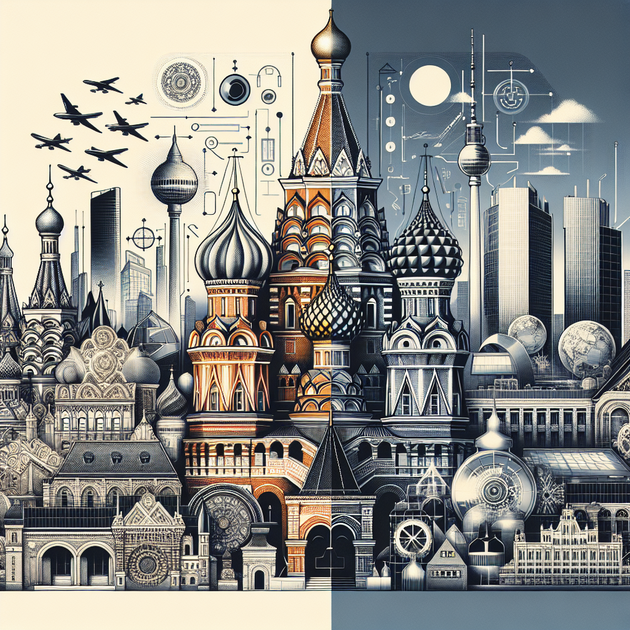Title: Russian Stability vs German Progress: A Surprising Balance of Two Worlds
Slug: russian-stability-vs-german-progress
Primary Keyword: Russian stability vs German progress
Secondary Keywords: Russian stability, German progress, cultural differences, economic development, European history
Meta Title: Russian Stability vs German Progress: Surprising Contrasts & Lessons
Meta Description: Explore Russian stability vs German progress—how these two nations balance tradition and innovation. What can we learn from their approaches today?
Focus Keyphrase: Russian stability vs German progress
Tags: Russia, Germany, culture, stability, progress, history, economics, Europe, innovation, tradition
Excerpt: Why do some nations value stability while others chase progress? Dive into the fascinating contrasts between Russian stability and German progress—and what we can learn from both.
OG Title: Russian Stability vs German Progress: Surprising Contrasts & Lessons
OG Description: Discover how Russia and Germany embody stability and progress—exploring cultural roots, economic choices, and what they teach us about balancing old and new.
Twitter Description: Russian stability vs German progress—two different paths, each with unique strengths. What can we learn from their approaches to tradition and change?
Image Prompt: A split scene showing Moscow’s classic architecture on one side and Berlin’s modern skyline on the other, symbolizing tradition versus innovation.
—
Russian Stability vs German Progress: A Surprising Balance of Two Worlds
Why do some countries seem to hold onto tradition while others are always chasing the next new thing? The comparison of Russian stability vs German progress goes a lot deeper than just stereotypes or memes—it’s about how history, culture, and priorities shape a nation’s path. Let’s explore how Russia and Germany have chosen such different routes, what drives their choices, and what lessons each has to offer.
Understanding Russian Stability
When you think of Russia, images of vast landscapes, grand cathedrals, and deep-rooted traditions might come to mind. Stability in Russia isn’t just about politics—it’s woven through the culture. There’s a real sense that order, resilience, and continuity help people weather tough times. This focus on stability has historical roots.
From the days of the Russian Empire to the Soviet Union and modern Russia, leaders have often promoted unity and order as a way to keep such a huge country glued together. According to Encyclopaedia Britannica, Russia’s sheer size and diversity have made central control a go-to strategy for centuries.
But stability isn’t just a government thing—it shows up in daily life too. Many Russian families value close-knit communities and traditions passed down through generations. There’s comfort in the old ways—whether it’s gathering for tea or sticking with time-tested recipes.
Germany’s Drive for Progress
Now let’s look at the German side of the story. Progress is almost a national motto. Germany is known for its engineering marvels, cutting-edge design, and a knack for reinventing itself. The country has bounced back from countless challenges by embracing change—sometimes with breathtaking speed.
This drive for innovation has deep roots as well. After World War II, Germany had to rebuild almost everything from scratch. Instead of just restoring the old ways, Germans seized the chance to rethink how things could work better. Today, the country is a global leader in fields like renewable energy and manufacturing.
According to Deutsche Welle, Germany’s “Energiewende” (energy transition) is a prime example of how a culture of progress can reshape an entire nation.
Key Differences: Stability vs Progress
While both approaches have their strengths, they sometimes pull in opposite directions. Here are a few ways Russian stability and German progress stand apart:
- Tradition vs Innovation: Russians often place a higher value on preserving customs; Germans are quick to adopt new ideas.
- Community vs Individualism: Stability thrives on group cohesion; progress often rewards personal initiative.
- Risk Tolerance: Russians may be more cautious about change; Germans are more likely to experiment.
- Economic Models: Russia leans on natural resources; Germany bets on technology and exports.
- Political Culture: Centralized authority is common in Russia; Germany favors decentralization and local autonomy.
What Can We Learn from Both?
There’s a classic story that sums up these differences: A German engineer and a Russian craftsman are both given a broken machine. The German draws up a new blueprint and starts building a better version from scratch. The Russian takes a look at what’s there, fixes what works, and finds a way to keep it running with whatever parts are on hand.
Neither approach is “right” or “wrong”—they each have their moments. Russian stability helps communities pull together during hard times. German progress pushes society forward when new ideas are needed. The real magic happens when these strengths combine—like when a tried-and-true tradition meets a fresh innovation.
For example, many global companies now blend Russian resilience with German efficiency to get the best of both worlds. Even in areas like science and education, collaborations between Russian and German institutions are producing exciting results—check out this article from the Goethe-Institut for some recent joint projects.
The Balancing Act: Tradition and Change
So, what does all this mean for the rest of us? Maybe it’s a reminder that stability and progress aren’t enemies—they’re teammates. Every country (and every person) has to find their own mix. Sometimes you need a strong foundation to build on; other times you have to break away from old habits to create something better.
At the end of the day, the debate between Russian stability vs German progress isn’t just about nations—it’s about how we all handle change in our own lives.
Which side do you lean toward—sticking with what works, or reaching for something new? Let us know your thoughts below!
—
Image Prompt: A split scene showing Moscow’s classic architecture on one side and Berlin’s modern skyline on the other, symbolizing tradition versus innovation.

Leave a Reply